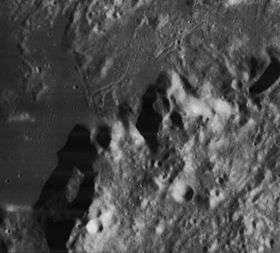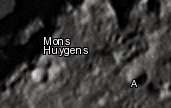Mons Huygens
| Mons Huygens | |
|---|---|
 Lunar Orbiter 4 image of Mons Ampère (below left of center) and Mons Huygens (above right of center) | |
| Highest point | |
| Elevation | 5.5 km |
| Listing | Lunar mountains |
| Coordinates | 19°55′12″N 2°53′24″W / 19.92000°N 2.89000°W |
| Naming | |
| Translation | Mount Huygens (Latin) |
| Geography | |
| Location | the Moon |
Mons Huygens is the Moon's tallest mountain (but not its highest point).[1] It is about 3.3 miles (5.5 km) high and is located in the Montes Apenninus.[1] The Montes Apenninus were formed by the impact that created Mare Imbrium. Adjacent is Mons Ampère to the west. Further west is the crater Huxley.
The mountain was named after the Dutch astronomer, mathematician and physician Christiaan Huygens, it was officially named by the IAU in 1961.[2]
Understanding size
| Mountain | km high |
|---|---|
| Huygens | 5.5 |
| Aeolis | 5.5 |
| Denali | 5.5 (btp) |
| Blanc | 4.8 (asl) |
| Uhuru | 4.6 (btp) |
| Fuji | 3.8 (asl) |
| Zugspitze | 3 |
Mons Huygens is 5.5 km (18,000 ft) high, about the same height as Aeolis Mons located on Mars in the middle of Gale crater, and taller than Mons Hadley located on the Moon further north, which was visited by Apollo 15. The tallest mountain known in the Solar System is in Rheasilvia crater on the asteroid Vesta, which contains a central mound that rises 22 km (14 mi; 72,000 ft) high; Olympus Mons on Mars is nearly the same height, at 21.9 km (13.6 mi; 72,000 ft) high.
In comparison, Mount Everest rises to 8.8 km (29,000 ft) altitude above sea level (asl), but is only 4.6 km (15,000 ft) (base-to-peak) (btp).[3] Africa's Mount Kilimanjaro is about 5.9 km (19,000 ft) altitude above sea level to the Uhuru peak;[4] also 4.6 km base-to-peak.[5] America's Denali, also known as Mount McKinley, has a base-to-peak of 5.5 km (18,000 ft).[6] The Franco-Italian Mont Blanc/Monte Bianco is 4.8 km (16,000 ft) in altitude above sea level,[7][8] Mount Fuji, which overlooks Tokyo, Japan, is about 3.8 km (12,000 ft) altitude. Compared to the Andes, Mons Huygens would rank outside the hundred tallest peaks, being roughly the same height as Argentina's Cerro Pajonal; the peak is higher than any above sea level in Oceania, but base-to peak it is considerably shorter than Hawaii's Mauna Kea and its neighbors.
Surroundings

See also
References
- 1 2 MP - Mons Huygens
- ↑ "Mons Huygens". Gazetteer of Planetary Nomenclature. USGS Astrogeology Research Program., accessed August 19, 2017
- ↑ Mount Everest (1:50,000 scale map), prepared under the direction of Bradford Washburn for the Boston Museum of Science, the Swiss Foundation for Alpine Research, and the National Geographic Society, 1991, ISBN 3-85515-105-9
- ↑ "Kilimajaro Guide—Kilimanjaro 2010 Precise Height Measurement Expedition". Retrieved May 16, 2009.
- ↑ S. Green – Kilimanjaro: Highest Mountain in Africa – About.com
- ↑ Adam Helman, 2005. The Finest Peaks : Prominence and Other Mountain Measures, p. 9: "the base to peak rise of Mount McKinley is the largest of any mountain that lies entirely above sea level, some 18000 feet"
- ↑ Sumitpostorg – Zugspitze
- ↑ "Mont Blanc shrinks by 45cm in two years". Sydney Morning Herald. November 6, 2009.
External links
- USGS - Mons Huygens
- Mons Huygens at the Moon Wiki
- Annotated map (source)